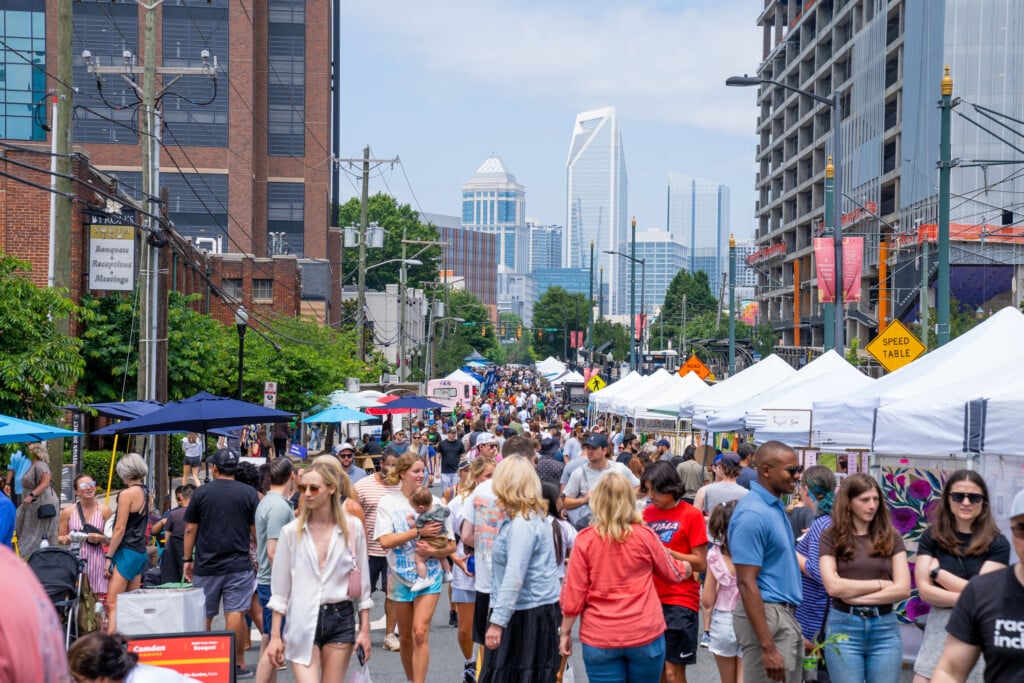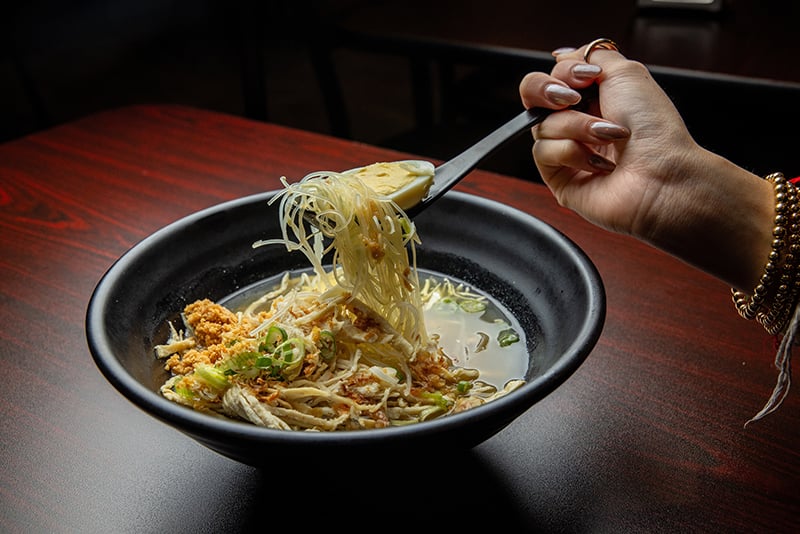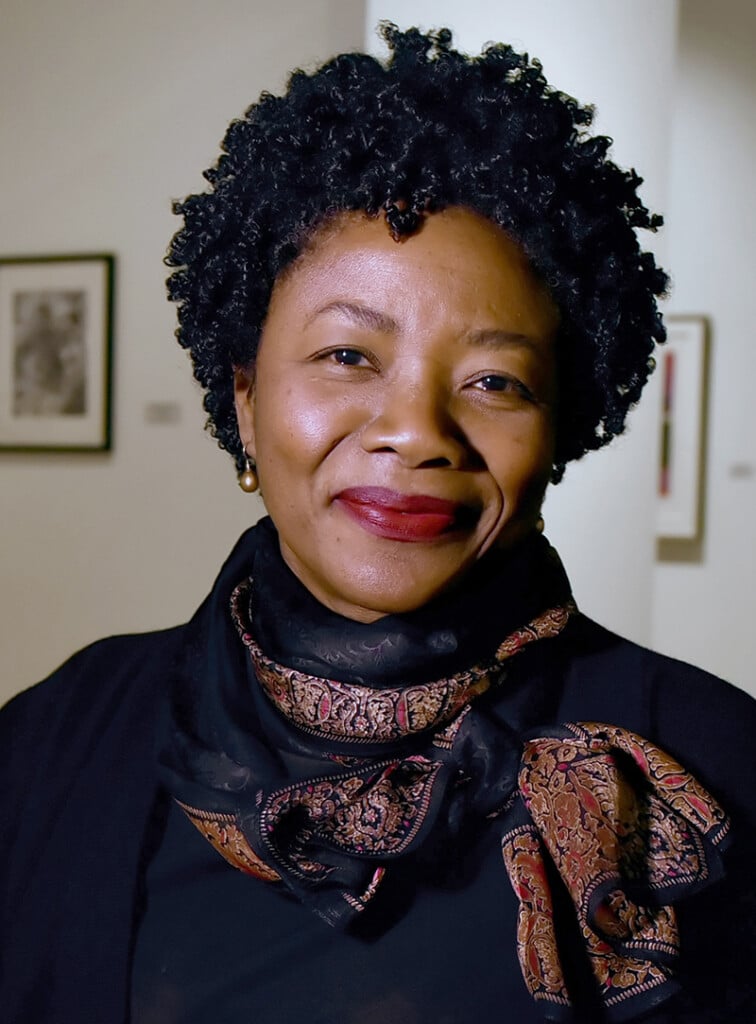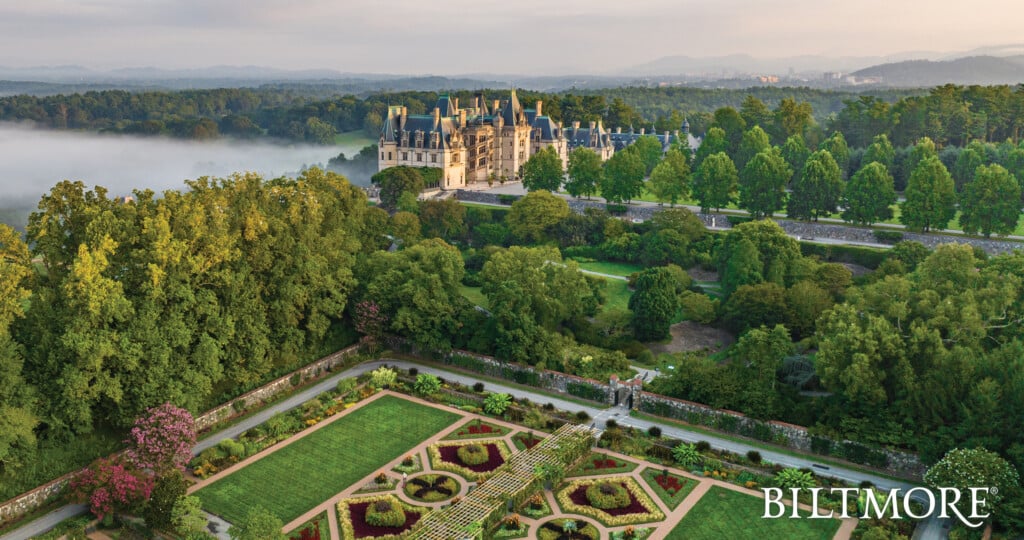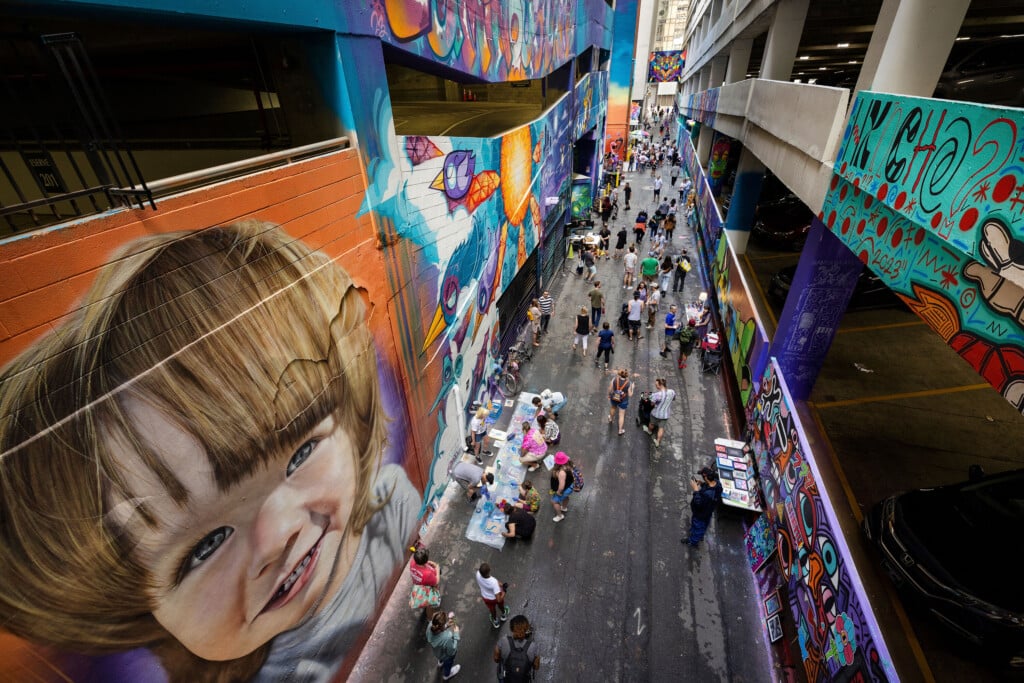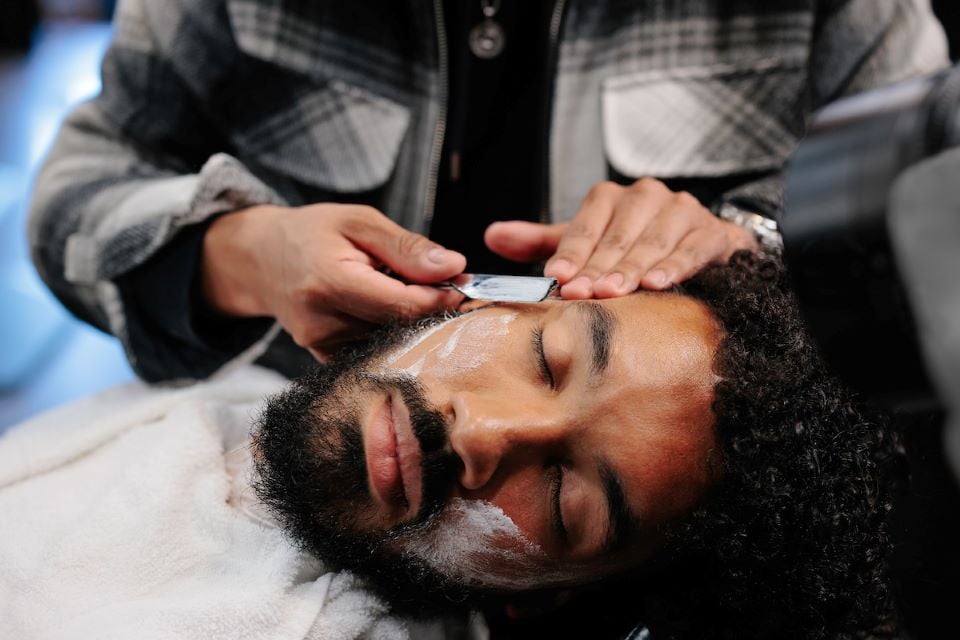That Autumn: An Essay
How Charlotte’s racist past echoed in the streets after Keith Lamont Scott’s death three years ago
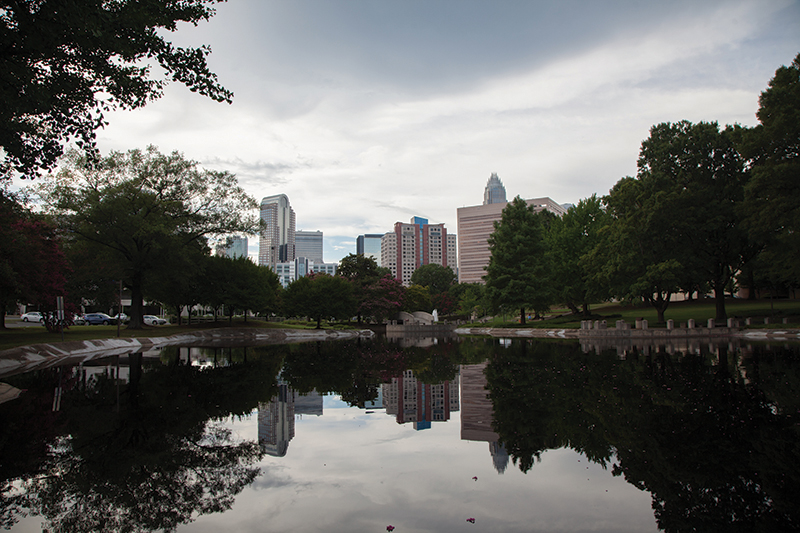
Listen to an audio version of this essay below.
On the last official day of summer, a Wednesday in late September, I woke to an ashen dawn. Overnight, the weather had shifted from sweltering heat to highs predicted only in the 70s. Local and national news covered the same story: The previous afternoon, a fifteen-minute drive from my home in Charlotte, a police officer had shot and killed Keith Lamont Scott, a black man.
The day had already begun out of the ordinary. My three-year-old daughter was home from preschool, having gone to bed the night before with a fever. Keeping her home meant I’d miss my weekly prayer group at church. So, while my daughter slept longer than usual, I spent the morning reading about Scott’s death: protests late into the night, crowds that turned violent, an interstate shut down. I considered my sick girl and released a breath of gratitude for a fever and the excuse to remain home. I thought of my friends in prayer group and imagined their white faces turned toward me, the one black person, full of questions. “Why, Patrice? Why the violence? Why the riots?” I had my hunches, but I didn’t actually know. What I wanted to avoid was feeling forced into being a spokesperson for my race. I knew all I would be thinking was, “Again?” and “Will this ever end?”
Our nation had witnessed a tumultuous summer of police shootings of black men—Alton Sterling in Baton Rouge, Philando Castile in Minnesota, and, just days before, Terence Crutcher in Tulsa—as well as civilian shootings of police officers. That day, a hazy gray blocked any hope of sunlight and crippled the present with the weight of an overcast sky.
***
In the days that followed Keith Scott’s death in September 2016, large groups marched through uptown, carrying signs with phrases like “Resistance is Beautiful” and “Justice 4 Keith Lamont Scott.” The city declared a state of emergency, implemented a curfew, and called in the National Guard. I found myself wondering if the events unfolding in this city—a place I had only recently started to think of as home—were about more than one police shooting of one black man and the question of whether he was armed. As debate unfolded, I returned to my research of a long-gone black neighborhood that once occupied a portion of Charlotte’s city center. Several days before, I’d started digging into the history of Brooklyn. Now I studied the past against the city’s backdrop of tension. Perhaps this place I happened to be investigating held answers to my speculations. I made my way to Charlotte’s main library, blocks away from where, at other hours of the day, masses gathered and marched through the city streets.
A few years after I’d moved to Charlotte, I first learned about the old Brooklyn neighborhood during the Community Building Initiative’s bus tour about the city’s lesser-known history. We pulled out of Little Rock AME Zion church’s parking lot and turned right on McDowell Street. We lumbered past government buildings and the county courthouse and turned right again onto Martin Luther King Jr. Boulevard. Here, local historian Tom Hanchett’s voice boomed with facts, speaking of stores, houses, churches, and schools that once lined these streets.
“We’re now in the heart of Brooklyn,” he said. I looked through the window at the couple of commercial towers, the squat government buildings, the aquatic center set back from the street. I searched for a remnant of the thriving black community that once occupied this space. Barber shops and dentist’s offices. A high school and more than a handful of churches. Hanchett spoke about urban renewal, the federal government’s mid-twentieth century efforts to—as it claimed at the time—clean up blighted urban areas. From my public-policy studies years before, I knew that, across the country, those “blighted” neighborhoods targeted for destruction were mainly black communities. If I’d stepped off the bus at that moment, I would have heard nothing but a few cars rushing past. No voices or greetings, no music or heels tapping against pavement. A typical story, I thought that morning, as I considered other communities urban renewal had leveled. My new city had a story to match so many others. Hanchett mentioned a plaque that commemorated what once existed on the land, but the bus rumbled past before I could spot it.
After Keith Scott’s death, my thoughts toggled between present and past. How does this city’s story connect with the crowds chanting at night in uptown? Maybe tucked within faded documents and old city plans lay the reasons behind the so-called riots: evidence found in old maps with black neighborhoods outlined in red and the construction of new highways that ripped these communities apart. I thought I could prove, at least to myself, that an uprising stems from the accumulation of every injustice perpetuated and every dream quashed.
***
On the second or third day of the protests, I sat on my patio, and my daughter ran across the front lawn in a light drizzle. A smear of sunshine worked through the clouds, and the air was sharp with the scent of cut grass. My daughter stopped mid-spin and turned to face my direction. She lifted her hand and waved.
While I watched her ordinary antics, I spoke with a white friend who’d called and said he wanted to check on us. I understood and appreciated his concern. He recognized the distance between the effect of the city’s disruption on black and white people. “Are you all OK?” my friend asked. His was a question not about physical health and well-being but something more elusive: How are you coping emotionally?
“I’m not OK. We’re not OK,” I said with a clipped honesty. “Not OK” lacked the gravity of what stirred within me. A thesaurus of options later settled into my thoughts: terrible, gutted, angry, terrified, frustrated—none of which I conveyed to him.
Instead, I added, “None of us in this country is OK.” Even if he didn’t realize it, even if his insides didn’t bubble with the emotional intensity those living in black bodies experienced, he wasn’t immune to the impact of recent days. Maybe I thought of entire neighborhoods destroyed. Perhaps I considered how Charlotte had once been a model for school desegregation and had in many ways returned to separate and certainly not equal. Maybe I paused to consider Charlotte’s lack of upward mobility out of poverty. I’m sure I thought of the protesters and their words of resistance, reverberating through the night. The history of racism in our country breaks us all. How could any of us breathing this air ever be OK?
I wasn’t sure if my response startled my friend or not, or if a simple, “We’re fine,” might have been better. I reveled in the truth of my words, though, and allowed the silence to hang across the line.
***
Political upheavals in the 1890s—among the white elite, poor white people, and black people—created Brooklyn. In a bid to hold power, wealthy white people pushed a rhetoric of white supremacy that discouraged poor white people from allying politically with black people. White Southerners enforced the Jim Crow racial caste system with a brutal hand.
White landlords built rental housing for black people in several specific pockets of the city, including Second Ward. Over time, the city prevented black businesses from accessing “white” areas of town. The grocers, barbers, cobblers, undertakers, and other business owners located primarily in Second Ward. As the years passed, black Charlotteans built a robust community within the broader city. (No one knows who first called this place Brooklyn, but the name probably pays homage to the New York City borough annexed around the same time.)
I learned this information primarily while reading Hanchett’s Sorting Out the New South City: Race, Class, and Urban Development in Charlotte, 1875-1975. Old newspaper articles provided additional facts about how the city presented the urban renewal project. “We have a file all about Brooklyn,” one librarian told me. She handed me a worn manila envelope stuffed with articles that dated back to the mid-twentieth century. The clippings were thin and brittle in my fingers, and I unfolded the yellow paper with caution. The headlines proclaimed the word “slum” again and again and again: “Business Booms Where A Slum Once Festered.” “Slum Razing Project Approved By Council.” “First Slum Project Nearing Completion.”
“That place they tore down,” another librarian said, a short woman with brown hair that fell just below her pale face. “They just tore it down,” she repeated. She shook her head at the unseen “they,” the “they” from long ago. But how could we have expected a different outcome given the characterization of that community as only a slum?
***
One morning in those days after Keith Scott’s death, I emerged from my house while the early hours remained soft and still beneath a cape of darkness. That morning, after a night of peaceful protests and marches in other parts of the city, I stood at the lip of my road. I looked down the sidewalk in my predominantly black neighborhood to where soon I would pass cul-de-sacs and white picket fences.
In those days and weeks following Keith Scott’s death and the deaths of too many others, the nation once again argued about implicit bias, the preconceived ideas created in generations past about the dangers of black men. Bias against black boys in preschool classrooms. Bias against black students revealed in expulsion rates. Bias against black people in hiring practices. Bias against black men in the criminal justice system. Bias everywhere.
What I perceived in the next few hours—during my morning walk and later when I drove my daughters to school—is that my neighbors embraced a camaraderie born of crisis. We waved longer than normal and shared generous but wry smiles of understanding. It was as if, on that gray and drizzly day, we allowed our collective cry to ricochet between our homes and daily lives. My neighbor loaded his laptop bag into his car. He waved from the middle of the driveway, and I returned the gesture. I let my eyes lock with his for a brief moment, and I willed him to understand that I saw him.
***
A short list of places the city destroyed or displaced as it demolished Brooklyn: Myers Street Elementary School, Second Ward High School, the Phillis Wheatley branch of the YWCA, the original McCrorey YMCA, Taylor’s Modern Barber Shop, East First Street, South Long Street, Pearl and Boundary, Hill and Vance. The United House of Prayer for All People, Friendship Baptist Church, Brooklyn Presbyterian, East Stonewall AME Zion, the Church of God, Williams Tabernacle, New Emmanuel Congregational, St. Paul Baptist, Grace AME Zion, Bethel AME Zion, McKissick’s Shoe Shop, the Savoy Theater, Queen City Pharmacy, Alexander’s Funeral Home, Hall’s Meat Market, Mutt Culp’s Shoe Shine Parlor, and Jack’s Pool Room. Hortense McKnight’s beauty shop, which I imagine smelled of hot combs used to straighten coiled hair. The street where a child learned to balance on a bicycle. The tree where a pair of lovesick teenagers etched their initials into ancient bark, the front room where a baby learned to walk. The sidewalks children skipped down after school.

JONATHAN COOPER
A few remnants of the old neighborhood remain on South Brevard Street, such as Grace AME Zion Church. A smaller building nearby bears a mural—by Charlotte artist Abel R. Jackson III—of prominent Brooklyn residents Thad Tate, J.T. Williams, and W.T. Smith and the Mecklenburg Investment Company building at South Brevard and East Third streets.
In his 2014 essay “The Case for Reparations,” Ta-Nehisi Coates writes, “It is common today to become misty-eyed about the old black ghetto, where doctors and lawyers lived next door to meatpackers and steelworkers …” And I realize I’m susceptible to that gauzy view. I envision places where people cared for and supported one another, whether shoe shiner or business owner, and the sweet days before new highways knifed through black communities, splitting them apart, concentrating poverty, and relegating black people to the shadows of cities.
Coates goes on to say, “This segregationist nostalgia … ignores the fact that the old ghetto was premised on denying black people privileges enjoyed by white Americans.” Here I see the root of why I succumb to romanticizing Brooklyn—the very nostalgia Coates condemns. How could people choose to raze Brooklyn and then forget?
Charlotte couched the destruction of Brooklyn in a narrative about access to better housing and safer living for black residents. The mayor at the time used a sledgehammer to bash in the first building. None of the old articles I’d read at the library mentioned how city leaders ignored Brooklyn’s declining condition as they funneled resources into white neighborhoods.
Ultimately, the rise of a glossy city center eclipsed the unfulfilled promises of replacement housing, the insufficient funds given to relocate businesses, and the terrorism carried out by white communities when potential black neighbors came too close. Much of the displaced population would move to the West Side. Half a century later, lack of opportunity in many of these communities would contribute to Charlotte ranking dead last among American cities in economic mobility.
There’s no question that Brooklyn was the product of segregation. Still, Brooklyn matters because black Americans in Charlotte were able to build a thriving neighborhood in the midst of injustice. Even more, Brooklyn matters because Brooklyn was someone’s home—a home destroyed without permission or fair compensation. I want to honor this place for what it was, what it represented, and what it meant to people.
In 1973, toward the end of urban renewal and years after former Brooklyn resident Maggie Stinson lost her home and neighborhood, The Charlotte Observer quoted her as saying, “I sure loved it over there, ’cause it was home.”
***
I studied the history of Brooklyn, learned about the United House of Prayer for All People’s annual parade, and read about beauty shops and barbers. In two or three lines of an article, I discovered that a predominantly white church had purchased land and built on what once was part of Brooklyn.
I searched for anything church members might have said about the destruction of Brooklyn and its many black churches—about how, intentionally or not, it made space for a white one. Efforts to unearth that footnote in history produced little except the sense that the church’s presence in Second Ward is a result of urban renewal, not the cause. As I already knew, the church wasn’t the responsible entity. This line of inquiry helped me see, though, that I probably wanted to blame someone or something—but who? Gone are the people who dismantled Brooklyn: the City Council members who approved the project, the reporters who saw Brooklyn as a slum and little more, and the government agency that designated black neighborhoods high risks for mortgage loans, leaving them vulnerable to the whims of urban renewal and highway expansion.
So on a Sunday morning in late autumn, more than a month after Keith Scott’s death, I visited that church built over old Brooklyn. I sat in the pews, smiled at the people around me, and recognized what once was here. After the service, I walked along the neighboring blocks in the cool October air. At the intersection, I crossed over MLK Boulevard, turned right, and stopped in front of the Metro School, which uses the old Second Ward High School gymnasium. A cluster of black-and-white photographs surrounded by frames of mosaic glass hang as a memorial to Brooklyn. The street was washed in silence, void of cars or pedestrians on the sidewalk. Half a block later, I encountered a plaque—the same one I’d missed all those years ago on that bus:
SECOND WARD SCHOOL
1923-1969
SITE OF THE FIRST PUBLIC
HIGH SCHOOL FOR BLACKS IN
CHARLOTTE-MECKLENBURG
I continued down the street and turned onto another block. At Marshall Park, with its ponds and fountain splashing into a stone basin, I stood on the withering grass, in the shadows of sycamore trees shedding their autumn leaves, and existed on another continuum. Just weeks ago—not decades ago—crowds had gathered here. Protesters stood with other souls and remembered a man recently dead and so many other men gone, too. “No justice, no peace,” they cried as they walked in unison past the courthouse and county jail. “Black lives matter,” they chanted with handwritten signs hoisted high, stepping across the very ground where black lives had once lived. They marched for today and yesterday. They marched to remember Keith Scott’s life. And I think, without even realizing it, they marched for a lost Brooklyn, a place they never knew.
***
The June 5, 1977, Observer published a photograph of a man named Vernon Sawyer, who, as Charlotte’s Urban Redevelopment Commission director, oversaw Brooklyn’s demolition. He stares out over what was once Brooklyn. A few buildings tower in the distance. Tidy city blocks run parallel and perpendicular through the frame. Government buildings. Commercial property. A sprawling park. The caption under the photo reads, “Vernon Sawyer Looks Out On Brooklyn Today.” Four years earlier, Sawyer had reflected on the transformed city: “There isn’t any more Brooklyn. We ought to stop calling it that. Brooklyn is gone.”
He’s correct. Not a ghost of Brooklyn remains. Sawyer takes in the clean, sleek lines, a testimony to what men can both create and erase.
That day I’d visited the church built on old Brooklyn, I’d sat in a pew and stared up at the stained-glass window at the front of the sanctuary. Morning rays pierced the colorful panels of translucent glass, and their brilliance lured my gaze. When I turned from the sun, the remnant of direct light mottled my vision with streaks, lines, and speckles of black and bronze.
I closed my eyes tight to help my pupils recover, then opened them once more. No longer focused only on what lay ahead, I found that I could see the broader world, free from all that had distorted my sight.
Patrice Gopo is the author of All the Colors We Will See, an essay collection about race, immigration, and belonging. She lives in Charlotte.
